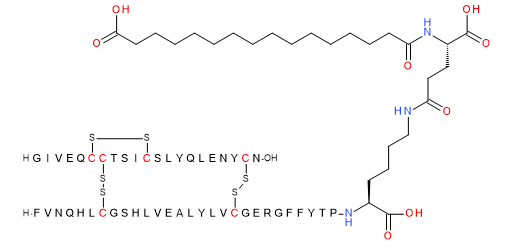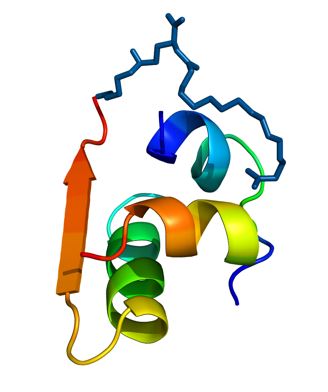
Long-acting insulin analogue
Category
Insulin
ID
NNC0100-0454
Amount per vial
1000 nmol (research grade purity)
Insulin is a peptide hormone acting as a key regulator of glucose homeostasis. Insulin binds to the insulin receptor (InsR), which exists in two alternatively spliced isoforms, InsR-A and InsR-B. The insulin receptor belongs to the same family of receptor tyrosine kinases as the IGF1 receptor (IGF1R) and insulin is therefore also able to bind to the IGF1R albeit with considerably lower affinity as compared to the insulin receptor.
NNC0100-0454 (also known as insulin degludec) is a long-acting insulin analogue with a C16 fatty diacid attached to lysine at position B29 (B29K) via a γ-L-glutamic acid linker and is therefore able to reversibly bind to serum albumin. In the marketed formulation containing zinc and phenol, this insulin analogue forms a depot of soluble multi-hexamers in the subcutis after subcutaneous injection. Over time the multi-hexamers slowly dissociate into monomeric entities that are absorbed into the circulation and through the fatty acid bind to albumin. These properties contribute to the long PK profile of NNC0100-0454.Category
Insulin
ID
NNC0100-0454
Amount per vial
1000 nmol (research grade purity)
| Property | NNC0100-0454 | Human insulin |
| MW (Da) | 6104 | 5808 |
| pI | 4.4 | 5.7 |
| Fatty acid | C16 diacid | - |
| Linker | gGlu | - |
| Sequence substitutions | DesB30 (Thr at B30 is lacking) | - |
| Sum formula | C274 H411 N65 O81 S6 | C257 H383 N65 O77 S6 |

Figure 1
2D sketch of NNC0100-0454. The B chain is lacking Thr at position B30 (desB30) and a γ-L-glutamic acid linker connects B29 lysine with a C16 fatty diacid.

Figure 2
3D structure of a NNC100-0454 monomer modelled on the basis of pdb entries 4AK0 and 4AJX.
Receptor binding and lipogenic potency data for NNC0100-0454 (unpublished data).
The in vitro receptor binding affinity of NNC0100-0454 relative to human insulin (HI) is shown in the table. The affinity was determined on human insulin receptor isoform A and B as well as on the IGF1R using solubilised holoreceptors in the presence of 0.1% (w/v) human serum albumin (HSA). The in vitro lipogenic potency was measured in isolated primary rat adipocytes by assessment of the incorporation of 3-[3H]-glucose into triglycerides (lipogenesis) in the presence of 0.1% (w/v) HSA. In all assays, NNC0100-0454 was a full agonist i.e. displayed the same maximal effect compared to that of human insulin. Since albumin binding is a key mechanism for the design of NNC0100-0454, be aware that the apparent affinity and potency will be very dependent on whether the in vitro assays contain albumin or not.
| Assay | HSA concentration [%] | Relative affinity/potency (95% CI) [% of HI] | IC50 (95% CI) [nM] |
| Receptor binding, human InsR-A | 0.1 | 9.2 (7.6 to 11) | 0.015 (0.013 to 0.017) |
| Receptor binding, human InsR-B | 0.1 | 11 (9.4 to 12) | 0.016 (0.011 to 0.024) |
| Receptor binding, human IGF1R | 0.1 | 2.6 (2.1 to 3.1) | 1.2 (0.77 to 1.9) |
| Lipogenesis, rat adipocytes | 0.1 | 3.6 (2.3 to 5.5) | - |
NNC0100-0454 displays a markedly protracted PK profile in vivo following a s.c. injection. Plasma PK parameters following i.v. dosing from a study in Sprague-Dawlay rats are given in the table below. For i.v. and s.c. studies in rats, dose levels of 1-5 nmol/kg and 5-30 nmol/kg, respectively, are recommended both for once and twice daily dosing studies. For the i.v. study in the table below, NNC0100-0454 was dissolved in 5 mM phosphate, 140 mM NaCl and 70 ppm polysorbate 20, pH 7.4. Please note that PK parameters for NNC0100-0454 is very dependent on the formulation used (e.g. the zinc content) due to its ability for form multi-hexamers upon subcutaneous injection under certain formulation conditions (see the Jonassen et al. 2012 reference listed in the reference section).
If using ELISA to detect NNC0100-0454 in your samples, ensure to use a kit that is able to detect this insulin analogue.
| Parameter | Value |
| Dose (nmol/kg) | 4.5 |
| T1/2 (h) | 2.3 |
| MRT (h) | 2.8 |
| CL (mL/kg/min) | 0.5 |
| Vz (mL/kg) | 10 |